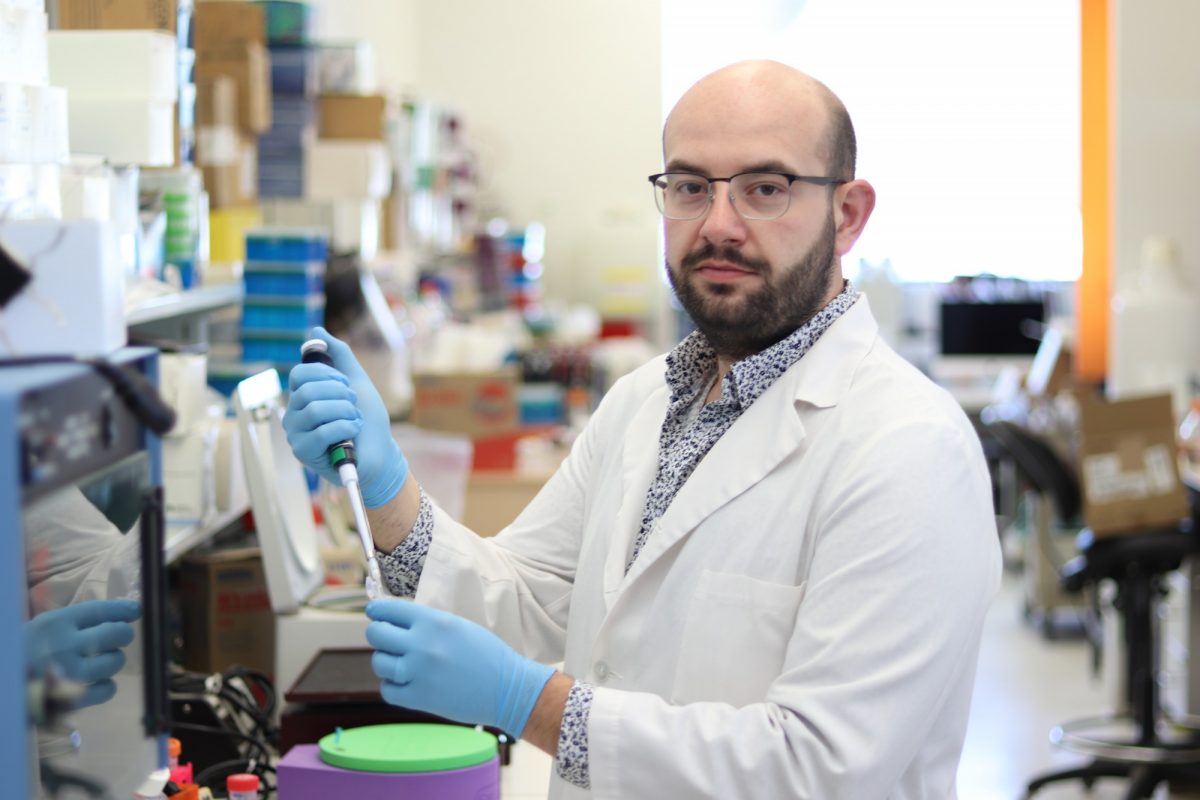
BERARDINO PETRELLI, A FOURTH-YEAR DENTISTRY STUDENT, IS ALSO completing a PhD IN BIOCHEMISTRY AND MEDICAL GENETICS.
Balancing two passions: Student pursues concurrent degrees in genetics, dentistry
Growing up in Winnipeg’s West End, Berardino “Dino” Petrelli was certain he wanted to become a dentist.
But as an undergraduate biochemistry student at the University of Winnipeg, he obtained special permission to do an honours project in a genetics lab at the UM medical college.
He was so enthralled by the lab’s work – led by Dr. Geoff Hicks, a genetic expert on fetal alcohol spectrum disorder (FASD) – that he stayed on from 2013 to 2017, completing a master’s in biochemistry and medical genetics.
The focus of his research under Hicks was on creating a genetic model of FASD in mice. The long-term goal was to pinpoint how much alcohol consumption during pregnancy, at what point of gestation, causes harm to the developing fetus.
“We didn’t actually give alcohol to the mice,” Petrelli says. “It had recently been discovered that in frogs, a deficiency of Vitamin A causes the same abnormalities as consuming alcohol. We were the first to replicate that in mice, which have embryology similar to humans.
“The reason Vitamin A deficiency mimics alcohol consumption is that in the pregnant mother’s body, alcohol, also known as ethanol, inhibits the enzymes that convert Vitamin A to retinoic acid. And retinoic acid is essential for normal early development of the fetus.”
By this point, Petrelli’s fascination with research had pushed aside his dentistry dreams.
Then something about the “FASD” mice seized his attention. He realized that the abnormal curvature of their snouts was a phenocopy – a genetic duplicate – of the under-researched “oral signature” of FASD in humans: a narrow oral cavity, high arched palate and misalignment of the upper and lower teeth, causing bite problems.
He suddenly envisioned a career combining dental expertise with craniofacial research.
“A lightbulb went off in my head. I thought, ‘Maybe I can join both my passions, go back to dentistry and keep my science moving forward.’”
In 2018, Petrelli embarked on his PhD in biochemistry and medical genetics, still in Hicks’ lab. The following year, he was accepted into the Dr. Gerald Niznick College of Dentistry. Now 31 years old, he is in his final year of dental school and also expects to complete his doctorate in 2023.
“Most people I spoke to thought it would be difficult to do both programs,” he says. “But I’ve had a lot of support from both the Hicks lab and my dentistry professors.”
Petrelli has devoted each summer to research in the lab. During the school year, he dashes from the dental college over to the nearby lab whenever he can – a setup that probably wouldn’t have been possible at a larger university, he says.
The Hicks team will soon start a retrospective study that is believed to be a global first: They will examine anonymized charts, including X-rays, of orthodontic patients in Manitoba who had a diagnosis of FASD, aiming to better understand the oral implications of the disorder. After that project, Petrelli says, the team plans to undertake a cohort study of individuals with FASD.
“One of my goals is to help dentists do better surveillance for FASD,” he says.
Petrelli’s long-term plan is to join academia, conduct craniofacial research, teach and have a part-time clinical practice. He says the skills he has honed as a researcher make him a better dentist.
“I’ve taken a lot of things with me from the lab into the clinical dental setting, like critical reasoning skills, knowing how to cope when something isn’t working – taking it all in stride – and team-building skills.”
One of his favourite aspects of dentistry is seeing a patient look in the mirror when a procedure is complete.
“I’m very glad that I pursued dentistry,” he says. “To see that instant gratification on the patient’s face just gives me a moment of joy. It helps me deal with the discouragement in research, where you often don’t get the outcome you expected and you have to go back to the drawing board. Together, they give me a nice balance.”






